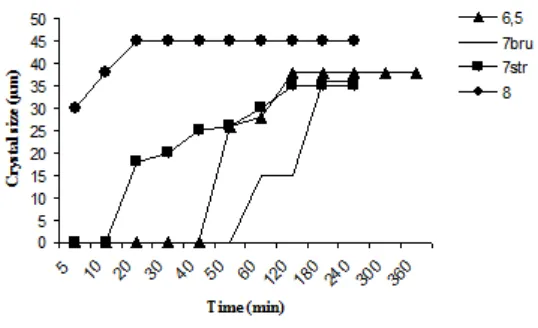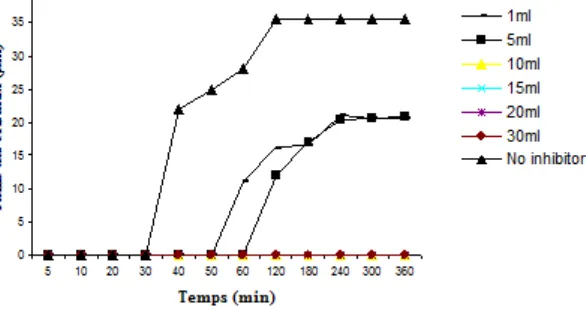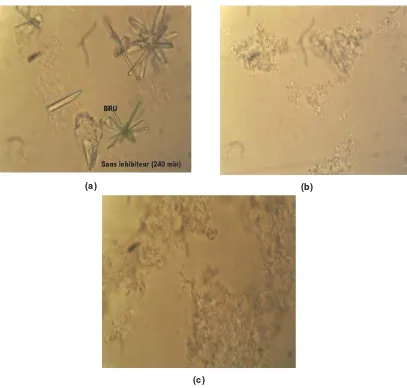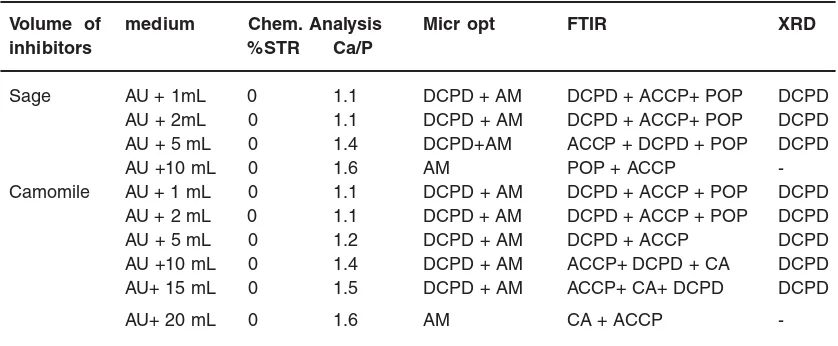INTRODUCTION
A large number of people in this world are suffering from problems due to urinary stones1,2. Urinary stone formation is a complex process that results from a succession of several physico-chemical events including supersaturation, nucleation, aggregation, and retention within tubules. Epidemiological data collected during several decades showed up 20 %, are composed mainly of calcic phosphates3. The calcic phosphates represent a complex family. Their survey is difficult
Effect of medicinal plants on the
phosphate crystallization at pH 6.5
AISSA BELOUATEK
1*, BRAHIM KACEM
1, MOHAMED BEGHALIA
1, AHMED AISSA
BENAHMED
1, AHMED ADDOU
1and AHMED SEMMOUD
2¹Laboratoire (STEVA) Faculté des sciences et sciences de l’ingénieur,
Université de Mostaganem, Algérie 27000 (Algeria). ²Laboratoire LASIR, Lille france, (France)
(Received: May 20, 2007; Accepted: June 06, 2007)
ABSTRACT
In this work, we performed an in vitro crystallization study enabling the specification of kinetic and thermodynamic conditions of formation and growth of crystalline calcic phosphates species by changing the pH. We used inhibitors, which are medicinal plants which prevent, slow down or reduce crystallization phases. We chose the classical model for the study of phosphate crystallization without inhibitor and with it, in order to assess the inhibiting capacity of any chemical species used. The precipitation of the solid phase of phosphates from artificial urine at different initial pH values was the object of our investigation. The crystal size development was monitored by polarized microscopy at different time intervals. After crystallization time, the mixture was filtered, the recovered dried precipitates were analysed by FTIR spectroscopy and X-rays diffraction technique and chemical analysis. In the absence of inhibitor, the crystallization of phosphates at pH = 6.5, led to the formation of brushite (DCPD) and amorphous carbonated calcium phosphates (ACCP), after 6 hours. In presence of inhibitor at pH = 6.5, at lower concentrations of sage inhibition was partial. The addition of 1 ml of sage to the mixture decreases the size of crystal, after 4 hours the size of crystals stabilized at 20.67 µm. The complete disappearance of brushite crystals was obtained after addition of 10mL of Sage, only Pentahydrated octocalcic phosphates (POP) and ACCP were formed. In the presence of Camomile, the inhibition of brushite growth and aggregation increased. The addition of up to a volume of 20 mL of Camomile resulted in total inhibition and crystalline transformation of the ACCP into carbapatite (CA). Phosphate compounds encountered in urine can be dangerous and the use of inhibitors to prevent, slow down or reduce crystallization phases might be very helpful. In this investigation, Sage and Camomile proved to be good inhibitors. Their effect increases with solution pH but they are more efficient in less acidic or neutral urine than in alkaline one.
Key words: Crystallisation; brushite; inhibition; medicinal plants; pH.
because of the cr ystalline species diversity composing them and the relative ease of the crystalline transformation that may take place. Most of the calcic phosphates is sensitive to the influence of the environment and particularly to mono or divalent ions of urine. These ions may move into crystal lattice and can alter the species under consideration. As a consequence, crystallization studies, more for the calcic phosphates than calcium oxalates, should grasp better the governing factors of crystallization1.
In this work, we performed an in vitro crystallization study enabling the specification of kinetic and thermodynamic conditions of formation and growth of crystalline species. The slow and
*To whom correspondence should be done
controlled diffusion of species to the growing crystals is very useful to study the growth and inhibition of brushite and struvite crystals in vitro. Different experimental procedures have been proposed using synthetic, diluted or natural supersaturated aqueous solutions of urine1. Crystallization can be triggered by adding, to reaction medium calcium, oxalates or phosphates, or by crystalline germination of the species under investigation. Crystallization can also take place, by changing the pH of substances having pH - dependent solubility1,2.
This also helps to develop different inhibition conditions, which can be extended to urinary calculi, by adding different inhibiting solutions. We used inhibitors, which are medicinal plants which prevent, slow down or reduce crystallization phases. They are plants capable of opposing, one or several steps of calcic salts lithogenesis (calcium oxalate, calcium phosphate), either by a specific mechanism of the crystal considered, or through a more general action mode. They work by complexing promoting ions, or by fixing themselves to growth sites, or through poly anions complex formation3-5.
Therefore, it is worthwhile to look for an alternative to these means by using medicinal plants[6-8]. In this regard, many plants have been used to treat kidney stones and showed to be effective among them Sageand Camomile.These plants are a Mediterranean traditional medicinal plant widely used in Algeria to treat lithiasis patients. Our study in vitro showed that extract from plants are used in urine owing to its possibility therapeutic potential as preventive agent hindering the formation calcic phosphates crystals.
EXPERIMENTAL
We chose the classical model for the study of phosphate crystallization because of its simplicity and satisfactory reproducibility. This model includes the study of crystallization without inhibitor and with it, in order to assess the inhibiting capacity of any chemical species used. Two solutions of following composition were mixed: A : 11.02 g/l Na2SO4.10H2O, 1.46 g/l MgSO4.7H2O, 4.64 g/l NH4Cl, 12.13 g/l KCl et 0.24 g/l Ca2+ and B : 2.65 g/l NaH2PO4.2H2O, 18.82 g/l Na2HPO4.12H2O, 13.05
g/l NaCl, 1 g/l Na3C6H5O7.2H2O et 0.05 g/l C2O42-. The solution in C2O42- is prepared from oxalic acid 0.05 g. The precipitation of the solid phase of phosphates from artificial urine at different initial pH values (pH = 6.5; 7 and 8) was the object of our investigation. Artificial urine is prepared by mixing and stirring two equal volumes of 50 ml of solutions A and B at constant temperature (37°C) in capped vessels to give final artificial urine at pH = 7. The pH of solution B was adjusted to required value by adding either HCl or NaOH as appropriate. Mixture agitation was maintained to prevent sedimentation. The crystal size development was monitored by polarized microscopy at different time intervals by proceeding as follows: Sample drops were examined every five minutes by polarising optical microscopy. Crystals were identified with x 40 magnifying lens. After crystallization time, the mixture was filtered, the recovered dried precipitates were analysed by FTIR spectroscopy, X-rays diffraction technique and chemical analysis.
Chemical analysis was performed using atomic emission spectrometer with inductively coupled plasma (Perkin Elmer 2000). Around 10 mg of precipitate was precisely weighed and dissolved in 0.2 ml of diluted (1:1) HCl. After further dilution with water to 100 mL this solution was analysed for the content of Mg, Ca and P. results expressed as mass of a respective element in unit volume of analysed solution, c(X), were converted into percentage of struvite contained in the precipitate and the molar ratio Ca/P in the solid remaining when STR was excluded.
Assuming that all determined magnesium was present in the form of struvite and considering that in this mineral the molar ratio Mg/P =1, then the percentage, in moles, of struvite in a sample can be expressed as molar
%STR = (moles of P as STR/total moles of P)*100. Applying the analytical protocol described, and converting moles to mass, the percentage in mass of STR in a simple can be expressed as
%STR = 127.4*c(Mg)/c(P) And the molar ratio Ca/P
Ca/P = [c(Ca)/40.08]/{[c(P)/30.97]-[c(Mg)/24.31]}
Preparation of medicinal plants
spring near to Mostaganem (west of Algeria). The extract was prepared according to a similar procedure used often by patients. Fresh herb was dried at 45 °C overnight, boiled in distilled water. The powder was reconstituted to prepare a solution of 15g/l in distilled water.
RESULTS
Study of the phosphate crystallization without inhibitors
Kidney phosphates stone is the result of supersaturation of urine with certain urinary salts such as calcic phosphates. Since crystallisable phosphate species are pH dependent, we studied their precipitation from artificial urine at different pH values. The crystallization of phosphates at pH = 6.5 in the absence of inhibitor, led to the formation of brushite and granulations identified by polarized light microscopy as the amorphous carbonated calcium phosphates (ACCP), which finally were transformed into brushite after 6 hours (Table 1). At pH = 7, both brushite and struvite are present and granulations were identified as being amor phous carbonated calcium phosphates (ACCP) (Table 1). The results showed that at pH = 8, crystals and granulations are respectively carbapatite and struvite (Table 1). The size of brushite crystals was more significant at moderately acidic pH values. The size of struvite crystals at
pH = 8 confirmed that alkaline environment is favourable to the struvite formation. The induction times for brushite crystals at pH 6.5 and 7 were respectively of 50 and 60 minutes. It can be noted that at pH = 6.5, artificial urine was more favourable to thermodynamically stable brushite formation at this pH1,9. The formation of brushite after 60 minutes, at pH = 7, is in agreement with the high stability of brushite at moderately acidic pH rather than at neutral pH. Induction time for the two solutions at pH = 7.5 and 8 tends toward zero, due to the fact that at high pH struvite crystallization is favoured. Struvite crystals appeared immediately, even when adding the B solution (Fig. 1). The results seem to agree with those obtained in the synthesis of the hydroxyapatite, octocalcic phosphates, withlockite, carbapatite, br ushite and the amor phous carbonated calcium phosphates (ACCP) 1,10,11. In fact, each calcium phosphate has a given molar precipitation concentration and pH dependent solubility product. The usual precipitation range of the calcic phosphates in urine is higher than pH = 6. In urine, as in aqueous solution, when phosphocalcic oversaturation is important (pH=7), apatites with a solubility product Ksp in the order of 10-55.96 are the first species formed. Then comes struvite and finally brushite with solubility product equal to 10-13.04 and 10-6.73 respectively12. The composition of precipitates prepared under different conditions is given in table 1.
These precipitates exhibited Ca/P molar ratio around unity that is a characteristic value for Brushite. Therefore, brushite(DCPD) CaHPO4.2H2O represented the principal constituent of these precipitates and content of other phosphates, namely (ACCP) and Ca8H2(PO4).5H2O (POP) (Table 1).
At pH > 7, precipitates are rich in magnesium. Struvite MgNH4PO4.6H2O (STR) accompanied with carbapatite Ca10(PO4, CO3, OH)6(OH)2; (CA) were the principal constituent at this pH. Their Ca/P ratio varying between 1.4 and 1.6.
Study of phosphate crystallization in the presence of inhibitors
We followed the same exper imental procedure for the study of crystallization in the presence of inhibitors. We focussed on brushite crystallisation because it may be the nucleating agent for many stones [8]. A value equal to 6.5 was chosen in this work as brushite is the most stable phase thermodynamically.
In order to assess the inhibiting potential of substances for phosphates and understand the mechanisms of action of these inhibitors on phosphate crystallization steps (nucleation, growth, aggregation), we tested the effectiveness of medicinal plants, Sage and Camomile on the crystallisation of brushite at pH=6.5. The same procedure as above (absence of inhibitor) was
followed. However, we added the inhibitors amounts corresponding to the physiological concentrations to one of the two (A and B) solutions before mixing, at the same temperature 37 °C. The plots of crystal size development as a function time follow the pattern as in the case without inhibitors. The same parameters (size and number of crystals, time of crystallization) were also investigated. Thus, knowing the size of crystals which are formed in the absence of inhibitor, it is easy to compare and to assess the role of the two inhibitors investigated. A series of experiments corresponding to the physiological concentrations of 1, 2, 5, 10, 15, 20, 30, 40, 50 and 50 mL of Sage and Camomile were carried out in order to cover the physiological excretion range. At the end of any experiment, the pH value was measured, because crystallogenesis in these conditions is pH-dependent. To ensure reproducibility the results were obtained in triplicate, with the coefficient of variance (CV<10%).
A six -hour test period was chosen for a pH = 6.5 9. The follow-up of the crystal size development by polarized light microscopy was carried out at time intervals of 5, 10, 20, 30 minutes to 6 hours of formation of crystals. Afterwards, the collected precipitates were analysed by FTIR spectroscopy and XRD diffraction to determine the structure of the components formed or possibly extinct.
Inhibition at pH = 6.5
The precipitation of calcium oxalate was Table - 1: Composition of precipitates formed in the short period
experiments at 37°C and different pH.
pH medium Chem. Analysis P.L.M. FTIR XRD
%STR Ca/P
6.0 AU 0 1.1 DCPD + AM DCPD + PACC DCPD
6.5 AU 0 1,2 DCPD + AM DCPD + PACC + POP DCPD
7.0 AU 10,3 1,4 STR+DCPD+AM DCPD + STR + PACC DCPD
7.5 AU 22,6 1,5 STR + AM STR + CA STR
8.0 AU 24,17 1,6 STR + AM STR + CA STR
P.L.M : polarized light microscopy, AU : artificial urine DCPD: Brushite, AM: Amorphous matter, STR: Struvite, ACCP: Amorphous carbonated calcium phosphates,
carried out in the absence and presence of sage and camomile. Results show that cr ystal mor phology depends considerably on the concentration of medicinal plant. Size of the crystal was found to decrease with increase in the concentration of medicinal plant and disintegration
of the crystal was also observed. It may be due to the formation of a soluble complex with Ca++ which reduces free Ca++ concentration in the bulk phase and increases calcium content in the filtrate. The size of crystals as a function of time is given in Fig. - 2 and 3.
Fig. - 2: Development of brushite crystal size as function of time at pH=6.5 for different concentration of sage.
Fig. - 3: Development of brushite crystal size as function of time at pH=6.5 for different concentration of camomile.
The results show that the addition of 1 mL of sage to the mixture not only decreases brushite crystal size from 22.1 to 11.4 µm but delays appearance time (from 50 to 60 min). The FTIR spectra of the precipitates were investigated in order to confirm inhibition presence. At pH = 6.5, a volume of 5 mL of sage remained insufficient to induce total
carbonated calcium phosphates. The FTIR spectrum confirmed this inhibition through the absence of characteristic peaks of the brushite. On the other hand, a crystal appearance delay (of 40 to 60 min) after the addition 1ml of Camomile, (of 40 to 120 min), for 5ml Camomile and (of 40 has 180 min), for 10ml the Camomile. We noticed a partial inhibition of brushite with a size reduction of 36.6%, 43.6% and 47.8% according to the volume of camomile added, i.e, 1, 5, and 10mL respectively. For volume added of camomile added (> 20mL) brushite inhibition was total (Fig. -4), as show by the complete disappearance of the characteristic band of the brushite. However the ACCP and CA
bands persisted. The composition of precipitates prepared under different conditions is given in table 2.
Fig. - 4 (photograph (b) and (c)) confirms the total inhibition of the brushite crystal after the addition 10mL and 20mL of the sage and camomile respectively.
For the total inhibition, predominant calcium phosphate constituting each precipitate is estimated on the Ca/P molar ratio realizing that it equals 1.4 – 1.6 for ACCP, POP and CA (Table 2).
Fig. - 4. a) Photograph of a grown brushite crystals.without inhibitors. b) Photograph of inhibition of brushite crystal after addition 10 mL of sage. C) Photograph of inhibition of
brushite crystal after addition 20 mL of camomile.
(a) (b)
It can be seen clearly from FTIR, XRD and chemical analysis that the aqueous extracts of Sage and Camomile produce a significant amount of inhibition on the growth of phosphate crystals. This in vitro study provides useful information for in vivo studies as well as prevention and inhibition of phosphate calculi in human body. However, the occurrence of phosphate calculi in the body is a much more complex phenomenon that is occurring under dynamic conditions in which ur ine continuously flows. Nevertheless, this in vitro study provides basic information to identify the potent inhibitors. Both of these aqueous extracts contain many complex macro-biomolecules and the roles of these molecules are very important in the growth and inhibition study.
CONCLUSION
Phosphate compounds encountered in urine can be dangerous and the use of inhibitors to prevent, slow down or reduce crystallization phases might be very helpful. In this investigation, medicinal plant proved to be a good inhibitor. Its effect increases with solution pH but it is more efficient in less acidic or neutral urine than in alkaline one. Inhibitory action is more significant on calcic phosphates than calcium oxalate. Medicinal plants are capable of reducing significantly in vitro hydroxyapatite crystallization; several works have
shown the capacity of plants acting against calcium phosphate growth. The addition of medicinal plants to phosphates stabilizes granulations and may retard for a certain time crystalline transformation. The results showed that the addition of 5 ml of sage at pH=6.5 resulted in 120 minute delay of bushite formation. Inhibition was total with 10 ml sage concentration but ACCP persisted through. Sage provoked a crystalline transformation at pH=6.5, of ACCP and POP at all concentrations, since the POP doesn’t exist in the absence of inhibitor. The ACCP amount was minor after the addition of 10 ml volume. In the presence of camomile brushite growth and aggregation inhibition was significant even for small concentrations. Adding of 20 ml inhibited the formation brushite. This powerful effect of Camomile on brushite phase formation at pH = 6.5. The results seem in agreement literature data on the effect of medicinal plants on calcium phosphates crystallization, and growth.
The inhibition of growth of phosphate crystals by potent aqueous extracts of sage and camomile was quite considerable. The aqueous extract of sage (10 ml) produced maximum inhibition of Brushite crystal growth followed by the aqueous extract of camomile (20 ml), in vitro conditions. This study is useful to formulate the necessary dosages to prevent and cure urinary calculi.
Table - 2: Composition of precipitates formed in the short period experiments at 37°C and pH = 6.5.
Volume of medium Chem. Analysis Micr opt FTIR XRD
inhibitors %STR Ca/P
Sage AU + 1mL 0 1.1 DCPD + AM DCPD + ACCP+ POP DCPD
AU + 2mL 0 1.1 DCPD + AM DCPD + ACCP+ POP DCPD
AU + 5 mL 0 1.4 DCPD+AM ACCP + DCPD + POP DCPD
AU +10 mL 0 1.6 AM POP + ACCP
-Camomile AU + 1 mL 0 1.1 DCPD + AM DCPD + ACCP + POP DCPD
AU + 2 mL 0 1.1 DCPD + AM DCPD + ACCP + POP DCPD
AU + 5 mL 0 1.2 DCPD + AM DCPD + ACCP DCPD
AU +10 mL 0 1.4 DCPD + AM ACCP+ DCPD + CA DCPD
AU+ 15 mL 0 1.5 DCPD + AM ACCP+ CA+ DCPD DCPD
AU+ 20 mL 0 1.6 AM CA + ACCP
-P.L.M : polarized light microscopy, AU : artificial urine DCPD: Brushite, AM: Amorphous matter, STR: Struvite, ACCP: Amorphous carbonated calcium phosphates,
1. Jungers P., Daudon M., Le Duc A. La lithiase urinaire. Médecine Sciences Falmmarion Paris, 1-34 (1989 ).
2. Daudon M. Plaidoyer pour une meilleure exploration des lithiases rénales. Leurobiologiste, Tome XXXI, N°227; 17-75 (1997).
3. Atmani F., Slimani Y., Mimouni M., Aziz M., Hatch B. and Ziyyat A. Effect of aqueous extract from Her niari Hirsuta L.on experimentally nephrolithiasic rats. J of Ethnopharmacology; 95; 87-93 (2004). 4. Ryall RL, Marshall VR. The effect of urine,
pyrophosphate, citrate, magnesium and glycosaminoglycans on the growth and aggregation of calcium oxalate crystazation in vitro. Clinica Chimica Acta, 112; 349-356 (1981).
5. Bigi A, Falini G, Foresti E, Gazzano M, Ripamonti A, Roveri N. Magnesium influence on hydroxyapatite crystallization. J Inorg Biochem; 49: 69-78 (1993).
6. Gogte V.M, Ayurvedic Phar macology andTherapeutic uses of medicinal plants,
REFERENCES
Bhartiya Vidya Bhavan’s SPARC, Mumbai, (2000).
7. Reh Y.J., Chen H.S., Yang G.J., Zha H., Acta Pharm. Sin., 29: 204 (1994).
8. Bisaz S, Felix R, Nelman WF, Fleesch. Quantitative determination of inhibitors of calcium phosphate precipitation in whole urine. Nephrologie, 5: 175-179 (1984). 9. Grases F, Sôhnel O, Vilacamp A.I, March J.G.
Phosphates precipitating from artificial urine and fine structure of phosphate renal calculi. Clinica Chimica Acta; 244; 45-67 (1996). 10. Pak CYC. Potential etiologiquc role of
brushite in the formation of calcium (renal) stones. J Crystal Growth; 53: 202-208 (1981).
11. Nancollas GH, Koutsoukos PG. Calcium phosphate nucleation and growth in solution. Prog Crystal Growth Charact; 34: 129-102 (1980).




